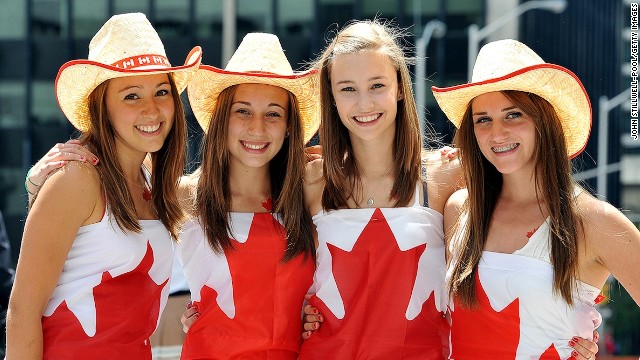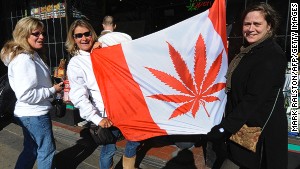- Back to Home »
- How to pretend you're Canadian

- A Canadian flight booking site says "flag jacking" the maple leaf still gets Americans better service abroad
- Body language expert Mark Bowden suggests travelers employ the "Canuck crinkle" when they smile
- Travel website offers tips on how to look Canadian using body language
- Canadians feel the need to apologize for everything, says the Canadian author
(CNN) -- Back in the summer of 1999, along with thousands of other Canadian twenty-somethings, I set out on a post-collegiate backpacking trip through Europe.
While on a train from Munich to Amsterdam, I looked across the aisle and spotted another solo female traveler.
Like me, she had a large Canadian flag sewn to the top of her backpack.
"Where in Canada are you from?" I asked, happy to be sharing the long journey with a fellow poutine eater.
But something wasn't right.
She began to squirm and wouldn't look me in the eye.
"Um, Toronto," she said.
After a bit of interrogation, she came clean.
She was actually from Minnesota -- close enough to her northern neighbor that her accent wouldn't immediately alert suspicion, but far enough away, culturally speaking, that her attempt at deception was doomed to wither beneath the suffocatingly courteous inquiry of a curious Canuck.
Her admission was understandable.
Eight hours is a long time to try to fool a Canadian into thinking you're one of the tribe.
Ugly Americans a thing of the past?
In 1999, my American train mate's attempts to deceive were somewhat forgivable.
The U.S. military was hot and heavy in Kosovo. Americans weren't looked upon favorably in many international quarters.
But do today's Americans still feel the need to jack the Canadian flag while traveling abroad?
I wouldn't have thought so.
After all, these days it's the Chinese who are being called "the new ugly Americans."
Yet according to Canadian flight booking website FlightNetwork.com, pretending to be Canadian by wearing that glorious red maple leaf still gets Americans better service when they're abroad, provided they're able to act the part, too.
In honor of Canada Day on July 1 -- remember that date if you want to have a hope in h-e-double-hockey-sticks of fooling anyone -- the Ontario-based site brought in a body language expert to provide tongue-in-cheek advice on how Americans and Brits can try to fake their Canadian-ness.
"Using quintessentially Canadian symbols, body language and facial expressions is a time-tested way to enhance the travel experience abroad," says Allison Eberle, vice president of operations for FlightNetwork.com.
"It's not surprising that travelers from other nations would do their best to come off Canuck."

The site commissioned body language expert and author Mark Bowden of TruthPlane Inc. to demonstrate "faux Canadiana contortions that immediately betray a 'flag-jacker' -- be they American, English or other."
Here are a few tips he lays out in the video.
The Maple-o-gy: A Canadian gesture showing submission by raising the shoulders in an apologetic motion, presenting oneself as nonthreatening.
The Canuck Crinkle: Showing the creases around your eyes when smiling -- indicates genuine friendliness.
The Toque Tilt: Slight tilting of the head when smiling, shows courtesy and congeniality.
Alternately, absence of the gesture can help you spot a fake Canadian.
Stars and Gripes Forever: Chin jutted out, face blank (or worse, frowning), causing the recipient of the message to assume something is wrong before the traveler has spoken.
American Psycho: A well-meaning but misplaced gesture in which arms are outstretched with palms down, above the heads of others, in an attempt to calm a situation ... a move that usually has the effect of escalating tensions.
The Polka-Loon: Overdoing friendly head tilt in a manner that implies you might need pharmaceutical assistance.
This is all reasonable advice, but body language and Canadian flags alone won't fool anyone.
If you're really going to convince people you're Canadian, here are two more tips to throw into the mix.
Say you're sorry. For everything
"Is it true what they say? If a Canadian apologizes three times the maple fairy brings you a hockey puck signed by Rick Moranis?"
An American friend recently asked me this when I sent him an email apologizing multiple times for being unable to make it to a planned dinner.
Joke all you like, we're proud of our reputation for extreme politeness.
When two Canadians accidentally bump into one another, a bizarre ritual often ensues.
No matter who's at fault, both parties will apologize. Repeatedly.
It's a reflex. If you stick out your leg and trip me, I'll say "sorry" to you. After all, I could have hurt your foot.
"Did you know he's Canadian?"
When a celebrity comes from the Great White North, no Canadian can resist pointing it out to non-Canadians who might be within earshot.
When Pamela Anderson, Paul Anka, Jim Carrey, Leonard Cohen, Keanu Reeves, Ryan Gosling, Ryan Reynolds, William Shatner, Linda Evangelista or Dan Aykroyd come up in conversation, you'll see us fidget and grow visibly agitated till we have a chance to blurt out "Did you know he/she is from Canada!?"
Study this list of famous Canadians before you hit the road. Shout out their nationality proudly to whoever is listening when they appear on TV or their music is played. You'll fit right in.
The only exception is when discussions turn to Justin Bieber or Celine Dion. You Americans can claim them as your own if you'd like. We don't mind.
Happy Canada Day!
Karla Cripps is a Canadian CNN digital producer based in Bangkok. Most people assume she is American until she says the word "about."







